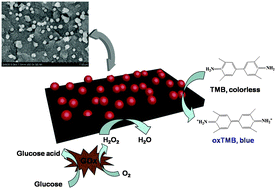Humic acid-assisted synthesis of stable copper nanoparticles as a peroxidase mimetic and their application in glucose detection†
Abstract
In this report, stable copper nanoparticles (Cu NPs) were prepared through a facile annealing process using humic acid as the reducing and stabilizing agents. The products were characterized by X-ray powder diffraction, scanning electron microscopy and Fourier transform infrared spectroscopy. The prepared Cu NPs show remarkably intrinsic peroxidase-like activity, which can rapidly catalyze the oxidation of the peroxidase substrate, 3,3′,5,5′-tetramethylbenzidine (TMB), in the presence of H2O2 to produce a blue-color reaction. The detection limit of H2O2 by Cu NPs can be as low as 1.32 × 10−7 M. More importantly, the prepared Cu NPs show excellent stability, which can hardly be oxidized even after 6 months. Based on the aforementioned mechanism, a simple, rapid and selective colorimetric method for glucose detection was developed, and the detection limit of glucose was 6.86 × 10−7 M. This study provides a novel method for the preparation of stable Cu NPs, which may have widespread applications in the detection of glucose in the human body and pear juice.


 Please wait while we load your content...
Please wait while we load your content...